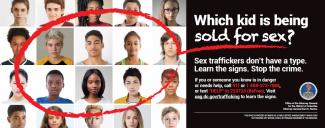Sex Trafficking: Learn the Signs. Stop the Crime.
When you think of sex trafficking, do you think of a young girl in another country who has been kidnapped and is being held against her will? While this may be the case for some survivors, the fact is sex traffickers target all types of individuals, here and abroad.
It’s important to dispel the myths and understand the realities of sex trafficking—a terrible crime in which victims are forced to exchange sexual acts for anything of value. Sex traffickers can target anyone, a friend or a family member, and children are most at risk. Here are some of the most common misconceptions about sex trafficking:
MYTH: Sex traffickers only exploit young girls.
FACT: Sex traffickers don’t have a type. They target individuals regardless of age, gender, race, sexual orientation, and socioeconomic background.
MYTH: Sex trafficking mainly happens in other countries.
FACT: Sex trafficking is an international crime industry that has been reported in all 50 U.S. states and the District of Columbia.
MYTH: There is nothing I can do to stop sex trafficking.
FACT: EVERYONE can help stop sex trafficking by learning how to spot and report the crime and knowing how to support survivors.
OAG works year-round to build awareness about sex trafficking through educational resources and trainings at schools and community centers. This year, OAG launched a public service announcement campaign (pictured above) in D.C. metro buses to raise awareness that anyone can be a victim of sex trafficking. This campaign directs people to resources that teach them how to spot this crime and how to seek help for themselves or someone they know. In addition to this PSA, OAG hosted its inaugural Citywide Child Sex Trafficking Leadership Roundtable this month, bringing together community-based organizations, local businesses, and District agencies to discuss ways to collaborate to support survivors and to inform the attendees about OAG’s education and awareness campaign.
Do you know how to spot the warning signs of sex trafficking? Learn to recognize the red flags, which include:
- Running away from home
- Not attending school
- Having large amounts of cash or other unexplained valuable items
- Dating someone significantly older
- Signs of physical abuse such as burn marks, bruises, or cuts
- New tattoos (traffickers often use tattoos as a form of branding)
Check out our new factsheet to learn more warning signs of sex trafficking.
If you or someone you know is in danger or needs help, call 911 or 1-888-373-7888, or text “HELP” to 233733 (BeFree).

